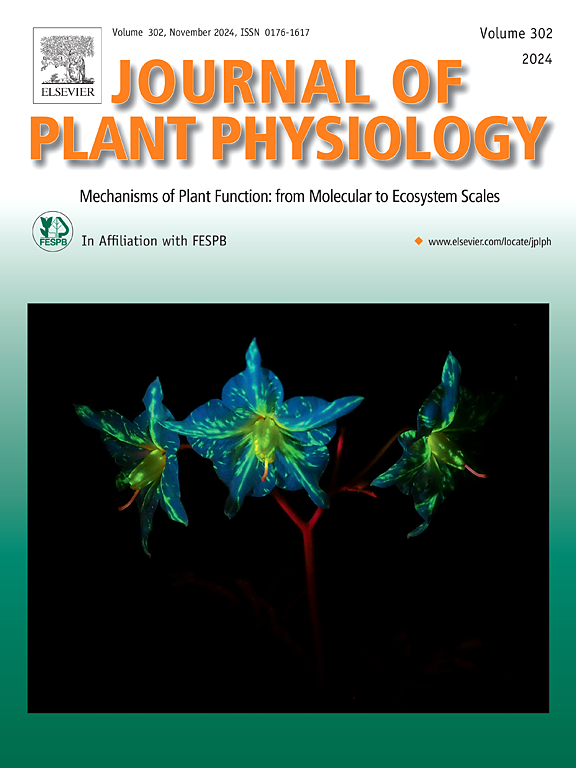LED 偏振光和涡流光对辣椒生长和光合特性的影响
IF 4
3区 生物学
Q1 PLANT SCIENCES
引用次数: 0
摘要
目前,大多数研究都集中在调节植物生长的传统光源上,而对 LED 内部发光的关注较少。本研究以 LED 光为对照,考察了偏振光和涡流光如何影响辣椒植物的生长和光合特性。研究结果表明,圆偏振光能显著增加辣椒的地上生物量。此外,偏振光和涡流光处理对辣椒的根系发育也有显著影响。与对照组相比,圆偏振光下的叶绿素含量最高,而线性偏振光下的 Pn、Sc、Tr 和 Ci 值最高,Rubisco 的酶活性也有所提高。圆偏振光显著提高了 POD、CAT 和 SOD 的活性,其中 SOD 的活性在左旋光下达到峰值。此外,在直线光和右涡流光处理下,MDA 的含量最低。在不同的偏振光条件下,叶绿素合成的关键基因(CaHEMA1 和 CaCAO)和抗氧化酶合成的关键基因(CaPOD、CaSOD 和 CaMDHAR)的表达发生了显著变化。总之,偏振光对辣椒的生长有重大影响,预计将被用于植物生长,为这一领域的未来研究奠定了基础。本文章由计算机程序翻译,如有差异,请以英文原文为准。
Effects of LED polarized and vortex light on growth and photosynthetic characteristics of pepper (Capsicum annuum L.)
Most studies currently focus on traditional illuminant regulating plant growth, while less attention has been given to the LED internal luminescence. This study examined how polarized and vortex light affect the growth and photosynthetic traits of pepper plants, with LED light used as the control. The findings indicated that circular polarized light significantly increased the aboveground biomass of pepper. Additionally, both polarized and vortex light treatment significantly influenced the root development of pepper. In comparison to the control group, the chlorophyll content was highest under circular polarized light, while the Pn, Sc, Tr, and Ci values were highest under linear polarized light, and the enzyme activity of Rubisco was increased. Circular polarized light notably increased the activities of POD, CAT, and SOD, the activity of SOD reached its peak under the left vortex light. Moreover, the content of MDA was observed to be the lowest under linear and right vortex light treatments. The expressions of key genes for chlorophyll synthesis (CaHEMA1 and CaCAO) and antioxidant enzyme synthesis (CaPOD, CaSOD, and CaMDHAR) were significantly altered under varying polarized light conditions, The latter genes, which play crucial roles in antioxidant enzyme activity, also showed significant variations in response to different polarized light treatments. In conclusion, polarized light significantly impacts the growth of pepper and is anticipated to be utilized for plant growth, setting the stage for future research in this area.
求助全文
通过发布文献求助,成功后即可免费获取论文全文。
去求助
来源期刊

Journal of plant physiology
生物-植物科学
CiteScore
7.20
自引率
4.70%
发文量
196
审稿时长
32 days
期刊介绍:
The Journal of Plant Physiology is a broad-spectrum journal that welcomes high-quality submissions in all major areas of plant physiology, including plant biochemistry, functional biotechnology, computational and synthetic plant biology, growth and development, photosynthesis and respiration, transport and translocation, plant-microbe interactions, biotic and abiotic stress. Studies are welcome at all levels of integration ranging from molecules and cells to organisms and their environments and are expected to use state-of-the-art methodologies. Pure gene expression studies are not within the focus of our journal. To be considered for publication, papers must significantly contribute to the mechanistic understanding of physiological processes, and not be merely descriptive, or confirmatory of previous results. We encourage the submission of papers that explore the physiology of non-model as well as accepted model species and those that bridge basic and applied research. For instance, studies on agricultural plants that show new physiological mechanisms to improve agricultural efficiency are welcome. Studies performed under uncontrolled situations (e.g. field conditions) not providing mechanistic insight will not be considered for publication.
The Journal of Plant Physiology publishes several types of articles: Original Research Articles, Reviews, Perspectives Articles, and Short Communications. Reviews and Perspectives will be solicited by the Editors; unsolicited reviews are also welcome but only from authors with a strong track record in the field of the review. Original research papers comprise the majority of published contributions.
 求助内容:
求助内容: 应助结果提醒方式:
应助结果提醒方式:


